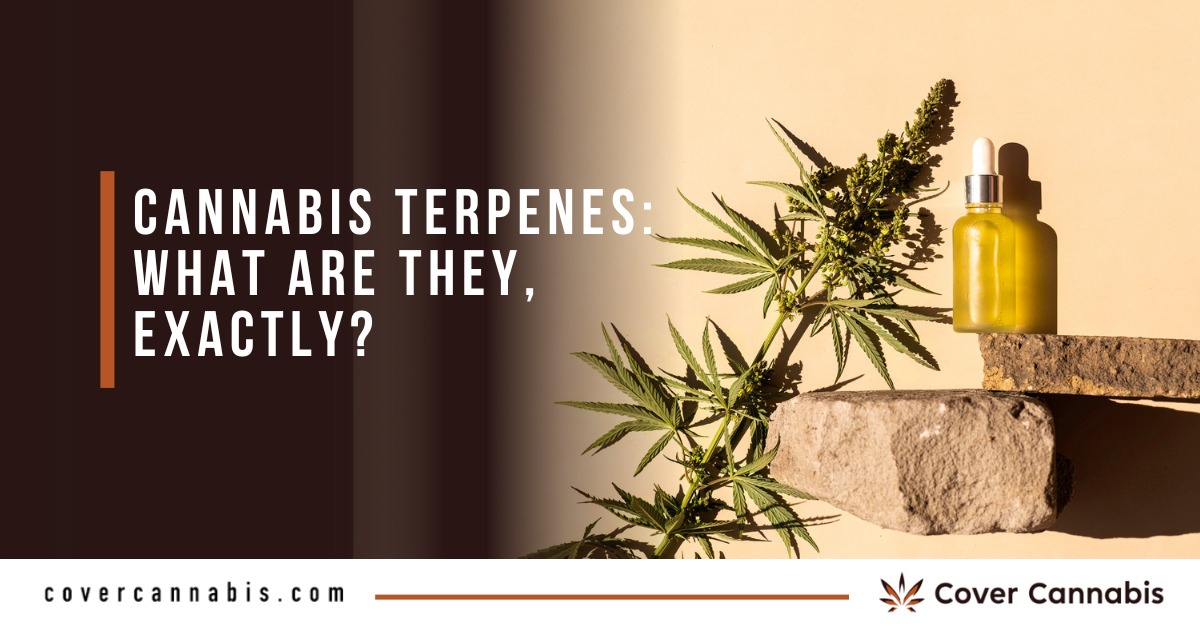


Cannabis terpenes are natural aromatic compounds found in the plant’s essential oils. They shape a strain’s scent and flavor — citrusy, piney, floral, spicy — and they also influence how cannabis feels in the body. Terpenes interact with cannabinoids like THC and CBD in ways that can amplify or balance effects. This interaction is often called the “entourage effect.”
As of 2025, research continues to explore terpenes for pain relief, stress management, inflammation, and sleep support. For consumers, they help explain why two products with the same THC can feel different. For businesses, they affect labeling choices, quality control, product liability, and insurance disclosures.

| Terpene | Common Non-Cannabis Sources | Frequently Reported Effects/Uses |
|---|---|---|
| Linalool | Lavender, mint, coriander | Calming; often discussed for stress and sleep support |
| Limonene | Citrus peels, juniper | Mood-elevating, bright aroma; used widely in topicals and edibles |
| Myrcene | Mango, lemongrass, hops | Relaxation, “couch-lock” associations; popular in night-time products |
| Humulene | Hops, sage, ginseng | Peppery, woody; frequently cited for anti-inflammatory potential |
| Pinene (α & β) | Pine needles, rosemary, basil | Crisp, pine aroma; commonly associated with alertness/focus |
When terpenes and cannabinoids are present together, they can shape each other’s effects. Examples often discussed include:
For patients and adult-use consumers alike, looking at terpene content (not just THC%) helps match products to goals like sleep, productivity, or pain relief.
| Strain | Dominant Terpenes (commonly reported) | Typical Experience |
|---|---|---|
| Blue Dream | Myrcene, Pinene | Relaxing body with an uplifted head feel |
| Sour Diesel | Limonene, Caryophyllene | Energizing, bright, citrus-diesel notes |
| OG Kush | Limonene, Myrcene, Caryophyllene | Grounding, stress-easing, complex flavor |
Terpenes influence branding, compliance, and risk:
Cover Cannabis can tailor forms to product-liability, crop, equipment breakdown, and compliance exposures tied to terpene-rich products.

For consumers, these methods often translate to richer flavor and more predictable effects. For producers, they support premium pricing and brand loyalty.
Summary of how key U.S. markets approach terpene testing, labels, and vape ingredient rules. Always check the latest state and local updates before printing.
| State | Is Terpene Testing Required? | Labeling & COA Notes | Special Rules for Vapes/Flavors |
|---|---|---|---|
| California (DCC) | No. Terpenoid testing is optional (“if applicable/available”). | If terpenoids are marketed on labels, distributors must complete QA checks; COAs may include terpenoids when tested. | General packaging/labeling rules; no statewide % cap specific to terpenes in vapes (verify local rules). |
| New York (OCM/CCB) | Not broadly required; terpene profile must be shown if marketed. | Labels require a terpene profile if you advertise terpenes; retain source records for botanically derived terpenes. | Inhaled/vaporized products: ≤10% total terpenes; synthetic terpenes prohibited; ingredient/recordkeeping rules apply. |
| Washington (LCB) | No general requirement. | Terpenes may be listed only if supported by certified third-party lab results; provide to consumers on request. | Characterizing flavors in cannabis vapor products must come from botanical terpenes mimicking cannabis profiles; synthetic terpenes disallowed. |
| Oregon (OLCC/OHA) | Not universal. | Labels focus on potency/warnings; COAs may include terpenes if tested. | Active rulemaking touches non-cannabis terpene additives; watch 2025 updates for hemp/cannabis items. |
| Colorado (MED) | No general terpene requirement. | Ingredient/additive accuracy required; terpene claims must match records. | Additives regulated by product type; no statewide terpene % cap similar to NY. |
| Massachusetts (CCC) | Not broad; stricter for vapes. | Vape labels must state terpene source (cannabis-derived vs. other). Keep COAs for terpenes/thickeners through wholesale. | Vape ingredient policies tie to FDA Inactive Ingredient or CCC database; strict disclosure language on terpene origin. |
| Michigan (CRA) | Not required for safety compliance. | COAs may include non-required items like terpenes if reported consistently with lab data. | Follow additive and vape safety rules; align records to CRA guidance. |
| Nevada (CCB) | No blanket terpene requirement. | Packaging/labeling under NCCR 12; verify terpene claims against current notices. | Recent updates address vape ingredients/labeling; confirm latest CCB guidance. |
Are terpenes only in cannabis? No. They’re common in citrus peels, pine, lavender, herbs, and more. Cannabis simply concentrates many of them together.
Do terpenes cause a high? No. Terpenes are not psychoactive, but they can shape how cannabinoids feel.
Can I benefit from terpenes without cannabis? Yes. They’re used in aromatherapy, food, and skincare for scent and experience.
How do I find a product’s terpene profile? Look for lab results and labels that include dominant terpenes; ask your dispensary for the COA.
This article is for informational purposes only and is not medical or legal advice. Always follow local laws and consult qualified professionals.